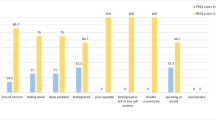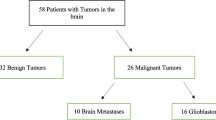Abstract
Purpose
Depression occurs among an estimated 15% of cancer patients (range, 1–77.5%). Our main objective was to identify the frequency of reported depression by using the Brief Edinburgh Depression Scale (BEDS) among cancer outpatients. Our secondary objective was to identify associated symptoms of cancer using the Edmonton Symptom Assessment System (ESAS) and to evaluate the screening performance of depression between ESAS and BEDS.
Methods
In this multicenter prospective study conducted, we used the ESAS to collect information on nine symptoms: pain, fatigue, nausea, depression, anxiety, drowsiness, shortness of breath, lack of appetite, and feeling of well-being (each rated from 0 to 10). The BEDS was used to assess for “probable depression” (score >6). Data were analyzed using a parametric and nonparametric test.
Results
A total of 146 patients completed the study. The prevalence of probable depression was 43/146 (29%). Probable depression was associated with increased fatigue (p = 0.008), depression (p < 0.0001), anxiety (p < 0.0001), shortness of breath (p = 0.01), and decreased feeling of well-being (p < 0.001). Among patients with probable depression, 42 (98%) patients were not using antidepressants. Regarding the sensitivity and the specificity, we determined that the optimal cutoff for using the ESAS as a depression screening tool was ≥2.
Conclusion
We found significant associations between probable depression as determined with the BEDS and five symptoms as detected with the ESAS. The vast majority of patients with probable depression were not receiving pharmacological treatment. Depression should be suspected in patients with higher symptom distress as for any one of these 5 ESAS items.
Similar content being viewed by others
References
Trask PC (2004) Assessment of depression in cancer patients. J Natl Cancer Inst Monogr 32:80–92
Hotopf M, Chidgey J, Addington-Hall J, Ly KL (2002) Depression in advanced disease: a systematic review. Part 1. Prevalence and case finding. Palliat Med 16:81–97
Meyer HA, Sinnott C, Seed PT (2003) Depressive symptoms in advanced cancer. Part 1. Assessing depression: the mood evaluation questionnaire. Palliat Med 17:596–603
Reeve JL, Lloyd-Williams M, Dowrick C (2008) Revisiting depression in palliative care settings: the need to focus on clinical utility over validity. Palliat Med 22:383–391
Mitchell AJ, Chan M, Bhatti H, Halton M, Grassi L, Johansen C, Meader N (2011) Prevalence of depression, anxiety, and adjustment disorder in oncological, haematological, and palliative-care settings: a meta-analysis of 94 interview-based studies. Lancet Oncol 12:160–174
Passik SD, Dugan W, McDonald MV, Rosenfeld B, Theobald DE, Edgerton S (1998) Oncologists' recognition of depression in their patients with cancer. J Clin Oncol 16:1594–1600
Fallowfield L, Ratcliffe D, Jenkins V, Saul J (2001) Psychiatric morbidity and its recognition by doctors in patients with cancer. Br J Cancer 84:1011–1015
Lawrie I, Lloyd-Williams M, Taylor F (2004) How do palliative medicine physicians assess and manage depression. Palliat Med 18:234–238
Breitbart W (1995) Identifying patients at risk for, and treatment of major psychiatric complications of cancer. Support Care Cancer 3:45–60
Uitterhoeve RJ, Vernooy M, Litjens M, Potting K, Bensing J, De Mulder P, van Achterberg T (2004) Psychosocial interventions for patients with advanced cancer—a systematic review of the literature. Br J Cancer 91:1050–1062
Rodin G, Lloyd N, Katz M, Green E, Mackay JA, Wong RK (2007) The treatment of depression in cancer patients: a systematic review. Support Care Cancer 15:123–136
Rayner L, Price A, Evans A, Valsraj K, Hotopf M, Higginson IJ (2011) Antidepressants for the treatment of depression in palliative care: systematic review and meta-analysis. Palliat Med 25:36–51
Stiefel R, Die Trill M, Berney A, Olarte JM, Razavi A (2001) Depression in palliative care: a pragmatic report from the Expert Working Group of the European Association for Palliative Care. Support Care Cancer 9:477–488
Jacobsen PB, Shibata D, Siegel EM, Lee JH, Fulp WJ, Alemany C, Abesada-Terk G, Jr, Brown R, Cartwright T, Faig D, Kim G, Levine R, Markham MJ, Schreiber F, Sharp P, Malafa M (2011) Evaluating the quality of psychosocial care in outpatient medical oncology settings using performance indicators. Psychooncology 20(11):1221–1227
Lloyd-Williams M, Dennis M, Taylor F (2004) A prospective study to determine the association between physical symptoms and depression in patients with advanced cancer. Palliat Med 18:558–563
Laird BJ, Boyd AC, Colvin LA, Fallon MT (2009) Are cancer pain and depression interdependent? A systematic review. Psychooncology 18:459–464
Lo C, Zimmermann C, Rydall A, Walsh A, Jones JM, Moore MJ, Shepherd FA, Gagliese L, Rodin G (2010) Longitudinal study of depressive symptoms in patients with metastatic gastrointestinal and lung cancer. J Clin Oncol 28:3084–3089
Salvo N, Zeng L, Zhang L, Leung M, Khan L, Presutti R, Nguyen J, Holden L, Culleton S, Chow E (2012) Frequency of reporting and predictive factors for anxiety and depression in patients with advanced cancer. Clin Oncol (R Coll Radiol) 24(2):139–148
DiMatteo MR, Lepper HS, Croghan TW (2000) Depression is a risk factor for noncompliance with medical treatment: meta-analysis of the effects of anxiety and depression on patient adherence. Arch Intern Med 160:2101–2107
Pelletier G, Verhoef MJ, Khatri N, Hagen N (2002) Quality of life in brain tumor patients: the relative contributions of depression, fatigue, emotional distress, and existential issues. J Neurooncol 57:41–49
Cukor D, Rosenthal DS, Jindal RM, Brown CD, Kimmel PL (2009) Depression is an important contributor to low medication adherence in hemodialyzed patients and transplant recipients. Kidney Int 75:1223–1229
Holland JC, Alici Y (2010) Management of distress in cancer patients. J Support Oncol 8:4–12
Satin JR, Linden W, Phillips MJ (2009) Depression as a predictor of disease progression and mortality in cancer patients: a meta-analysis. Cancer 115:5349–5361
Lloyd-Williams M, Shiels C, Taylor F, Dennis M (2009) Depression—an independent predictor of early death in patients with advanced cancer. J Affect Disord 113:127–132
Mitchell AJ, Kaar S, Coggan C, Herdman J (2008) Acceptability of common screening methods used to detect distress and related mood disorders—preferences of cancer specialists and non-specialists. Psychooncology 17:226–236
Rhondali W, Perceau E, Blay JY, Fournel-Federico C, Saltel P, Trillet-Lenoir V, Tredan O, Coulon JP, Bruera E, Filbet M (2012) Depression assessment by oncologists and palliative care physicians. Palliat Support Care 10(4), in press
Lees N, Lloyd-Williams M (1999) Assessing depression in palliative care patients using the visual analogue scale: a pilot study. Eur J Cancer Care (Engl) 8:220–223
Vignaroli E, Pace EA, Willey J, Palmer JL, Zhang T, Bruera E (2006) The Edmonton Symptom Assessment System as a screening tool for depression and anxiety. J Palliat Med 9:296–303
Wasteson E, Brenne E, Higginson IJ, Hotopf M, Lloyd-Williams M, Kaasa S, Loge JH (2009) Depression assessment and classification in palliative cancer patients: a systematic literature review. Palliat Med 23:739–753
Dugan W, McDonald MV, Passik SD, Rosenfeld BD, Theobald D, Edgerton S (1998) Use of the Zung Self-Rating Depression Scale in cancer patients: feasibility as a screening tool. Psychooncology 7:483–493
Lloyd-Williams M, Shiels C, Dowrick C (2007) The development of the Brief Edinburgh Depression Scale (BEDS) to screen for depression in patients with advanced cancer. J Affect Disord 99:259–264
Rhondali W, Perceau E, Saltel P, Girard R, Filbet M (2011) Translation and validation of Brief Edinburgh Depression Scale (BEDS) in French. Bull Cancer 98:199–208
Oken MM, Creech RH, Tormey DC, Horton J, Davis TE, McFadden ET, Carbone PP (1982) Toxicity and response criteria of the Eastern Cooperative Oncology Group. Am J Clin Oncol 5:649–655
Cummings G, Biondo PD, Campbell D, Stiles C, Fainsinger R, Muise M, Hagen N (2011) Can the global uptake of palliative care innovations be improved? Insights from a bibliometric analysis of the edmonton symptom assessment system. Palliat Med 25:71–82
Bruera E, Kuehn N, Miller MJ, Selmser P, Macmillan K (1991) The Edmonton Symptom Assessment System (ESAS): a simple method for the assessment of palliative care patients. J Palliat Care 7:6–9
Chang VT, Hwang SS, Feuerman M (2000) Validation of the Edmonton Symptom Assessment Scale. Cancer 88:2164–2171
Richardson LA, Jones GW (2009) A review of the reliability and validity of the Edmonton Symptom Assessment System. Curr Oncol 16:55
Bruera E, MacMillan K, Hanson J, MacDonald RN (1989) The Edmonton staging system for cancer pain: preliminary report. Pain 37:203–209
Cheung WY, Barmala N, Zarinehbaf S, Rodin G, Le LW, Zimmermann C (2009) The association of physical and psychological symptom burden with time to death among palliative cancer outpatients. J Pain Symptom Manage 37:297–304
Moro C, Brunelli C, Miccinesi G, Fallai M, Morino P, Piazza M, Labianca R, Ripamonti C (2006) Edmonton symptom assessment scale: Italian validation in two palliative care settings. Support Care Cancer 14:30–37
Carvajal A, Centeno C, Watson R, Bruera E (2011) A comprehensive study of psychometric properties of the Edmonton Symptom Assessment System (ESAS) in Spanish advanced cancer patients. Eur J Cancer 47:1863–1872
Zeng L, Koo K, Zhang L, Jon F, Dennis K, Holden L, Nguyen J, Tsao M, Barnes E, Danjoux C, Sahgal A, Chow E (2011) Fatigue in advanced cancer patients attending an outpatient palliative radiotherapy clinic as screened by the Edmonton Symptom Assessment System. Support Care Cancer
Kroenke K, Zhong X, Theobald D, Wu J, Tu W, Carpenter JS (2010) Somatic symptoms in patients with cancer experiencing pain or depression: prevalence, disability, and health care use. Arch Intern Med 170:1686–1694
Laird BJ, Scott AC, Colvin LA, McKeon AL, Murray GD, Fearon KC, Fallon MT (2011) Pain, depression, and fatigue as a symptom cluster in advanced cancer. J Pain Symptom Manage 42:1–11
Kroenke K, Spitzer RL, Williams JB (2001) The PHQ-9: validity of a brief depression severity measure. J Gen Intern Med 16:606–613
Thekkumpurath P, Walker J, Butcher I, Hodges L, Kleiboer A, O'Connor M, Wall L, Murray G, Kroenke K, Sharpe M. Screening for major depression in cancer outpatients: the diagnostic accuracy of the 9-item patient health questionnaire. Cancer 117(1):218–227
Schroevers MJ, Sanderman R, van Sonderen E, Ranchor AV (2000) The evaluation of the Center for Epidemiologic Studies Depression (CES-D) scale: depressed and positive affect in cancer patients and healthy reference subjects. Qual Life Res 9:1015–1029
Hann D, Winter K, Jacobsen P (1999) Measurement of depressive symptoms in cancer patients: evaluation of the Center for Epidemiological Studies Depression Scale (CES-D). J Psychosom Res 46:437–443
Luckett T, Butow PN, King MT, Oguchi M, Heading G, Hackl NA, Rankin N, Price MA (2010) A review and recommendations for optimal outcome measures of anxiety, depression and general distress in studies evaluating psychosocial interventions for English-speaking adults with heterogeneous cancer diagnoses. Support Care Cancer 18:1241–1262
Mitchell AJ (2010) Short screening tools for cancer-related distress: a review and diagnostic validity meta-analysis. J Natl Compr Canc Netw 8:487–494
Johnston M, Pollard B, Hennessey P (2000) Construct validation of the hospital anxiety and depression scale with clinical populations. J Psychosom Res 48:579–584
Berard RM, Boermeester F, Viljoen G (1998) Depressive disorders in an out-patient oncology setting: prevalence, assessment, and management. Psychooncology 7:112–120
Yennurajalingam S, Urbauer DL, Casper KL, Reyes-Gibby CC, Chacko R, Poulter V, Bruera E (2010) Impact of a palliative care consultation team on cancer-related symptoms in advanced cancer patients referred to an outpatient supportive care clinic. J Pain Symptom Manage. doi:10.1016/j.jpainsymman.2010.03.017
Temel JS, Greer JA, Muzikansky A, Gallagher ER, Admane S, Jackson VA, Dahlin CM, Blinderman CD, Jacobsen J, Pirl WF, Billings JA, Lynch TJ (2010) Early palliative care for patients with metastatic non-small-cell lung cancer. N Engl J Med 363:733–742
Hotopf M (2008) Review: screening or case-finding questionnaires used alone are not effective in the management of depression. ACP J Club 149:9
Acknowledgment
This research is supported by a grant from the Apicil Foundation.
Conflicts of interest
None.
Author information
Authors and Affiliations
Corresponding author
Rights and permissions
About this article
Cite this article
Rhondali, W., Perceau, E., Berthiller, J. et al. Frequency of depression among oncology outpatients and association with other symptoms. Support Care Cancer 20, 2795–2802 (2012). https://doi.org/10.1007/s00520-012-1401-3
Received:
Accepted:
Published:
Issue Date:
DOI: https://doi.org/10.1007/s00520-012-1401-3




